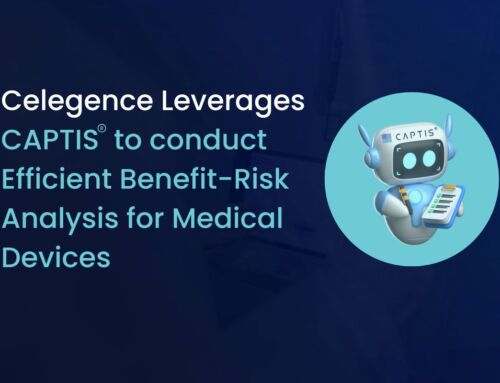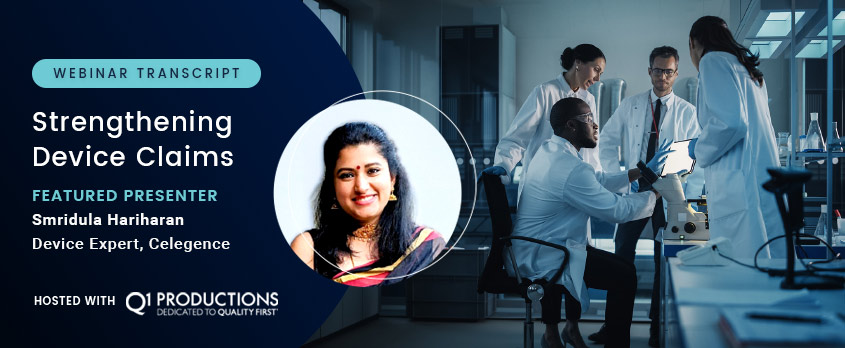
Strengthening Medical Device Claims – Webinar Presentation Transcript
Smridula Hariharan is a valuable member of the Celegence team due to her expertise and highly successful career in Regulatory Affairs. She has 9 Years of medical writing experience including medical devices and In vitro diagnostics. Experience spanning different therapeutic areas and all the different risk classes of devices.
Webinar Background:
One of the major hurdles faced by manufacturers while creating MDR compliant CERs is identifying clinical safety and clinical performance claims and their associated measurable clinical benefits. Another hurdle is defining the end points that can be used to establish that the device in fact achieves these claims and benefits. There are several considerations when determining the claims and their end points.
During our webinar titled “Unveiling Impactful Methods to Strengthen Device Claims”, Smridula Hariharan, spoke specifically about the best practices to determine measurable claims, identifying clinical endpoints or surrogate endpoints, to demonstrate conformity with General Safety and Performance Requirements (GSPRs) for MDR compliance.
Why should you read the transcript/watch this video?
The transcript blog will focus on four important aspects that will help strengthen device claims and make EU MDR complaint CERs
- Identifying claims
- Identifying associated benefits
- Defining End points for the benefits
- Defining type of data needed to support claims
A full transcript of Smridula’s presentation is available to download (and to read below) and just press play to watch the clip now.

Claim Your Free EU MDR Checklist Now!
Make sure you and your business are compliant with the new EU MDR. Get our 23 page checklist for actionable technical documentation requirements.
How to Identify Relevant Claims for your Medical Device
Hello everyone. We’re going to talk about how to identify relevant claims for your medical device so that the notified body does not raise any questions on your CER or PER. This is applicable to both medical devices and invitro diagnostics. But from the presentation perspective, we’re going to focus more on the requirements of MDR today.
EU MDR 2017/745, Article 7
I’d like to start off by just giving the definition of a claim as mentioned in the MDR. MDR article 7 says that the labelling instructions for use anything that cites what the intended purpose of the device is and gives the functions or properties of the device. If that ascribes to a function or a property, which the device does not have, or if it creates a false impression of either treatment or diagnosis or if it gives any kind of information that is misleading and may cause a risk to the patient who’s using the device, then it is actionable, and you cannot make such claims without having proof for it.
MDR Annex VII, p. 4.5.5
The other point that you must consider is that the intended use as specified by the manufacturer and whatever claims surround the device is one of the most important points that are evaluated by the notified body when they check clinical evaluation reports.
Identifying Valid Device Claims
Our goal is to understand how to best state and identify valid device claims. The next step would be how to identify evidence for these claims to show that these claims are valid, and we have proof that our device performs as intended.
Under the EU MDR (and the MDD) claims can come from any source. It is not limited to the operator’s manual or the IFU for the device, but any claim surrounding a device coming from any platform a website, social media, print, newspapers, anything is a valid claim. It is something that you should have evidenced for. If we do not have evidence to support this, then it is a problem and it should be taken down from any of these platforms so that it does not create any misleading information among the users.
You can see that print media, the company website, even advertisements that are run on TV are also actionable. If it does not have a claim that is valid, then it cannot be run on television as well.
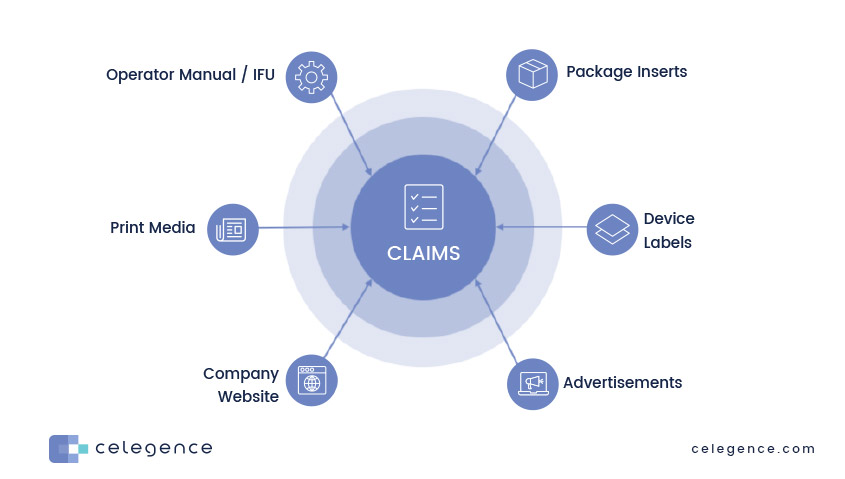
Types of Device Claims:
There are different types of claims that you can make for a device.
- Some of the claims are revolving around the safety of the device
- Some revolve around the performance
- Some are just technical claims
For the purpose of a clinical evaluation, your claim should be centered around clinical safety and performance claims.
Technical claims are related to the design features or something that the device can do that does not necessarily result in a clinical benefit. Those kinds of claims are technical claims. Since they do not have any benefit to either the patient or the user, it does not make too much sense to present them in a clinical evaluation report. Technical claims can always be presented in your technical file. But for a clinical evaluation, it’s usually restricted to clinical safety and performance claims.
The EU MDR Article 2-53 defines a clinical benefit as a positive impact that a device has on the health of an individual and it is necessary that these benefits are meaningful and can be measured.
Mainly because as I mentioned earlier, the goal of a clinical evaluation is to show that your device can achieve these clinical benefits. If they’re measurable and they have a meaningful outcome, that is the only way that you can prove that your device actually achieves these benefits or produces these benefits in the users.
Clinical benefit is slightly different from clinical performance, clinical performance is what the device does. It can be the same as the intended use of the device and then what impact this intended user, what impact this performance has on the patient is the clinical benefit.
Demonstrating Device Safety and Performance Claims
For demonstrating your safety and performance claims, you must identify the clinical benefit that is achieved. And then you must identify the endpoints for these benefits and demonstrate these endpoints within your CER.
For the purpose of the CER, there are two types of benefits:
- Direct benefits
- Indirect benefits
The direct benefits are benefits that the patient can experience using the device directly. For example, guide wires assist other medical devices in achieving their intended purpose as such a guidewire does not have any medical benefit to the patient. It does not either treat or diagnose any condition on its own, but in combination with say a stent or another interventional device, it helps in revascularization, or it helps in delivering valves or any other type of interventional devices. So, on their own, they do not have a clinical benefit. They have an indirect benefit by facilitating the delivery of another device to the location that it is intended.
Identifying whether your device has a direct or indirect benefit is essential at the very beginning of your clinical evaluation. This helps you plan what type of data you should have to demonstrate that your device achieves clinical benefit. It also helps you to come up with justifications in case you do not have clinical data for your devices.
Under the GSPRs and to demonstrate compliance with the GSPRs, it is expected that all devices have clinical data, but there are exceptions to this rule. So, to identify if your device falls under these categories, which can be exempted and which need not have clinical data, it is essential to identify what type of clinical benefits are associated with your device. So, there are clinical benefits where it helps in managing a procedure and that procedure in turn has a positive impact on the patient. This is one of those cases where the device as such does not have a direct medical benefit to the patient. It only has a positive impact on patient management, and this cannot be demonstrated via clinical evidence except clinical evidence for the main device or the main procedure that is being conducted.

Claim Your Free EU MDR Checklist Now!
Make sure you and your business are compliant with the new EU MDR. Get our 23 page checklist for actionable technical documentation requirements.
Identifying Valid Clinical Endpoints
There are a couple of guidances and a couple of documents that help in determining what clinical endpoints are, what counts as a valid endpoint and what type of endpoints can be considered.
Section c gives detailed information on how clinical benefits can be identified. It gives information on how these endpoints for these clinical benefits can be identified. What factors you should consider.
For example, it is essential to consider the duration of the clinical benefit experience by the patient. Is your device resulting in a short term benefit, is your device resulting in a benefit that extends over years? If there is an improvement in the quality of life, how long is that expected to last? These are some of the things that you are expected to identify and call out within your clinical evaluation plan, and then demonstrate via suitable data in your clinical evaluation report.
So oftentimes it’s that identifying these endpoints becomes a little bit of an issue. We’re not very sure what kind of endpoints we should consider for each benefit. Here is the guidance and consensus documents around the clinical condition of interest that your device either treats or diagnoses. Then there are industry standards, again, for that particular clinical condition or procedure that your device does.
State of the art (SoTA) – State of the art is also another very important source from where you can identify endpoints. Let’s take the example of state-of-the-art. Let’s go with the example of a catheter. You’re talking about a catheter that delivers a stent and therefore helps in revascularization. So, what type of endpoints should you consider and how do you make them measurable? So, for a catheter, let’s say it’s fairly simple to assume that one of the endpoints should be a safety endpoint and would be that there is limited mortality, morbidity, there’s limited dissections associated with the use of your device. So, when you say limited, that endpoint is valid, so having less dissections or having less mortality is an endpoint, but it is not measurable.
How do you make it measurable by quantifying it by saying my device has dissections in the range of say 2%, 3%, 4%. So, adding a value beside that makes that endpoint measurable and quantifiable. Something that you can demonstrate via your data. So how do you come up with these values and percentages? How do you determine if these values and percentages are acceptable? If you say 50%, your device will obviously have detections less than 50%, but is that a good claim to make? Is that something that is valid? How you can determine that is to check the state of the art. So, say you identify a benchmark device, you go through the literature for this benchmark device, and see what kind of data is available for your benchmark device. If your benchmark device has a dissection rate of 4% or 5%, you can set that as your limit for your own device. Then you can look through your data, your own clinical investigations and the literature published on your device to check if your device has dissections that fall within this rate. So, that would be a valid claim and a measurable claim. Something that you can easily demonstrate via the data that you have. Going through state-of-the-art and industry standards is a very good way of identifying endpoints and quantifying them.
Industry standards also often provide values that you can use in your claims. For example, say you are considering a device that is used for radiation therapy. There are several standards that surround what is the safe dose rate that can be dispersed by a radiation therapy device. So that value you can consider as your endpoint. Then you can say that my device safely delivers this dose rate within so and so square meters or within so and so area. The industry standards also specify certain things like what is considered accurate and precise during radiation therapy or during radiation delivery by device. So, those are things also that you can cite in your performance objectives.
You can say that my device follows industry standards, meaning it delivers radiation within this particular range. It delivers with this accuracy, with this precision, and those values can be obtained from industry standards and consensus documents. Once you have those values, you can go through your internal documents to see if your risk management documents and your internal testing, as well as any clinical investigations that you have, support these claims.
Surrogate End Points – What are they? When are they valid?
There is a scenario where you cannot have direct clinical outcomes and therefore you cannot have direct clinical claims. These come into play when you are considering indirect benefits. So, as we mentioned earlier indirect benefits are for those devices where they do not have a direct effect on the patient. They are not directly involved in either the treatment or diagnosis of a clinical condition that a patient is experiencing. So, in that case, you have two options. One is to say that your devices success or your devices safety and performance objectives can be only demonstrated through the safety and performance objectives of the main device with which it is used. For example, a device that measures blood pressure during a dialysis procedure, the actual device that measures the blood has no diagnostic value. Neither does it have any treatment value. The value entirely depends on the device that is performing the dialysis, but you can say with data that helps identify the flow rate or the access flow rate through the dialysis machine, we are able to optimize the dialysis settings and therefore deliver the best dialysis therapy to the patient. It’s helping us optimize patient management. So how do you demonstrate optimization of patient management? That is not something that will have a clinical outcome that you can measure, that is not something that will have a quantifiable number that you can measure. So, in these cases is where you use something that we call surrogate endpoints.
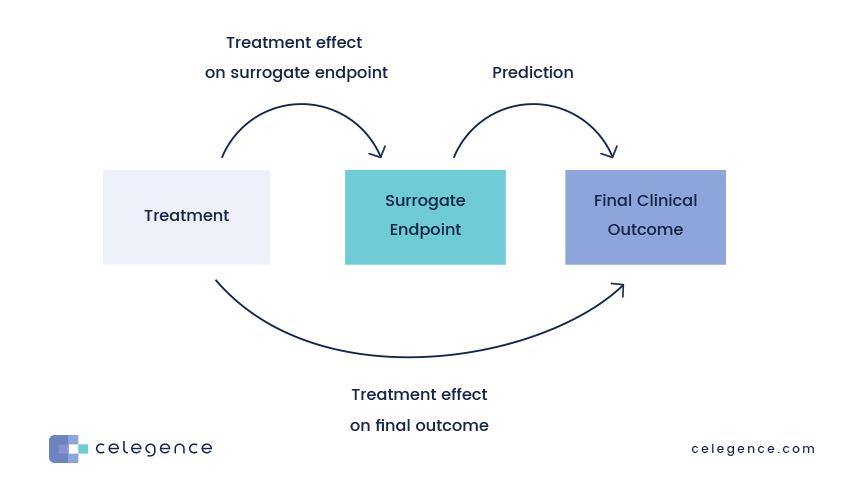
Surrogate endpoints are basically laboratory measurements or physical signs in some cases, biomarkers that are used as a substitute for a meaningful endpoint.
In cases where we are not able to directly measure how the patient feels or how the patient is benefited by our device, we can use a physical sign or another laboratory measurement, which is an indication of this final endpoint that we are hoping to demonstrate. So, in the previous example that I had given a device that measures flow rate, I am saying that by accurately measuring flow rate, my device is helping to optimize the dialysis therapy. My surrogate endpoint is just accurate and reproducible measurement of flow rate. If I’m able to demonstrate that I can extrapolate that data to say that because I’m able to accurately and reproducibly able to measure the flow rate, I’m able to optimize dialysis and dialysis is associated with beneficial patient outcomes, which can be measured for the dialysis system on its own. So, you use a surrogate endpoint to demonstrate a final clinical outcome.
Now, for these surrogate endpoints, you obviously cannot have clinical data to demonstrate it. It is in these situations that you can call on the exception and use non-clinical data to demonstrate compliance with your GSPRs and to demonstrate that your device achieves its clinical claim or has an actual benefit. It’s only in this case that you can use non-clinical data. So, it is expected to be a measure of the therapy that you are delivering, and therefore it is considered a final endpoint in its own right, but for any devices, which do not have a direct benefit, it is only for those devices that you can consider a surrogate endpoint.
For devices which have a direct effect on the patient. There are very rare scenarios where you can use a surrogate endpoint, unless it is unethical to measure the final outcome and to have clinical data to support that there is no other scenario where you can use a surrogate endpoint for a device, which has a direct benefit or a direct effect on patient treatment or diagnosis.
Appropriate Data for Claims
For direct clinical benefits, which have clinical endpoints that are measurable, you must provide clinical data.
Types of Clinical Data:
- Investigations that are either sponsored by the manufacturer or that you can find from external databases, these clinical investigations maybe investigator led, or they could be sponsored by another device, but has used your device as a competitor or a comparator. So those types of clinical investigations can be used
- Published literature on humans
- data from any registries where your device is being considered
- data from another device, which is used a subject device which does not have direct clinical data
- usability studies or human factor studies that have relevant data pertaining to your clinical endpoint
Types of Non-Clinical Data:
These can only be used for devices that do not have a direct clinical benefit and for which you have identified surrogate endpoints, and to demonstrate these surrogate endpoints, you can use non-clinical data.
These non-clinical data can either be obtained from
- Bench testing/verification/validation studies
- Pre-clinical studies that were conducted by the manufacturer. Usually this is biocompatibility data. It cannot be used for a performance endpoint, but biocompatibility data can be used when you are trying to claim a safety endpoint.
- Published animal studies. These published animal studies are usually for those devices where it is unethical to have clinical data like establishing that your device accurately performs something. Just to have that data conducting a study on humans, if it is unethical in that scenario, you can use data from animal studies as well.
CAPTIS™ – Our EU MDR & IVDR Technology Solution
We have a system at Celegence that we use to handle all of our literature data. One of the major sources of clinical information and in some cases, animal studies or non-clinical testing that is published is via literature search and handling large amounts of data from the literature search is a little difficult. To make this task a lot easier, we have a system within Celegence that we use, which is called CAPTIS™.
- It is an automated system that facilitates faster literature reviews, and it helps you perform adverse event analysis as well because this system has the feature to download Total Product Lifecycle (TPLC) data. It has the feature to download adverse event data from MAUDE as well. So, the adverse event analysis, as well as the literature reviews and analysis are a lot easier with the system.
- It is integrated with most of the commonly used databases like PubMed, Google scholar, Cochrane, Europe PMC. So, conducting a search on CAPTIS™ is easy and then screening the articles and documenting the L1 & L2 screening. Tagging these articles is also very easy. It’s something that simplifies the process of literature search and considerably reduces the amount of time that you spend on this activity.
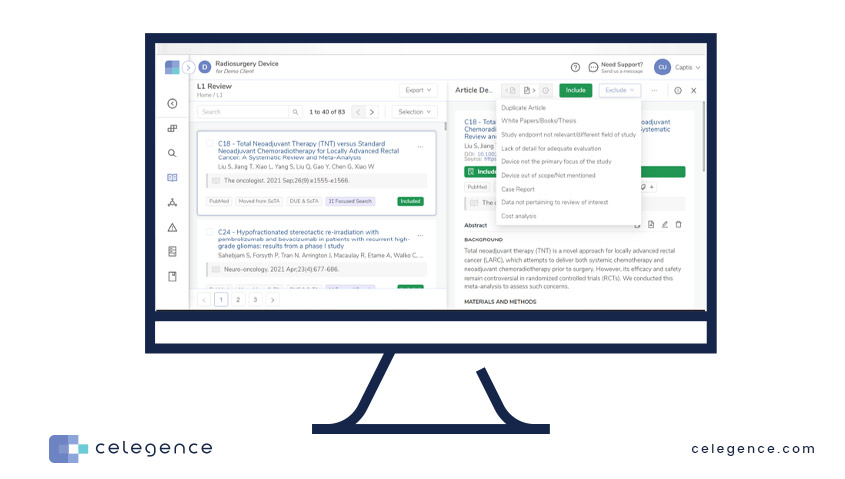
Benefits of CAPTIS™ Specific to Claims
- It helps for bulk import of search data, and then it automatically imports any free full texts that are available.
- There are audit trails for each article, so you can check what has happened with the article from the time when it was searched.
- There are also automatic triggers for any report updates, which is very useful when there are multiple people working on a document,
- There is a option for optimized data collection and storage.
- There are also forms that you can customize based on what you are looking for. In case you are looking for a particular claim or in case you are looking for a particular data set that you require to demonstrate compliance with your claims, tagging those articles, looking for specific keywords. It becomes very simple with this system, and it also accesses a repository for all of the data that you have, not only for a single project but multiple projects.
- There is also a correlation that can be done between different searches done on the same device. You can tag the articles and you can define if an article helps you support a specific safety claim. You can define if an article helps you support a specific performance claim, and then you can filter out these articles once you’ve tagged them. Apart from summarizing them under DuE, you can also separately pull out an export for just an article supporting your claims.
- You can also create summaries on the CAPTIS™ You can highlight important data that can be referred later on.
- You can also have the system where you tag or leave comments for specific people. So, if there are multiple people working on the system, you can leave comments for them.
- You can action a particular article based on what you feel is relevant but leave a comment so that everyone is aware of why this action was taken. You can also leave notes on articles.
It’s very user friendly and it helps to keep all the data together. So, if this is available, it significantly reduces the amount of time that we spend on the literature activity.
Sample Studies
- Direct Benefits
You can consider devices like stents. For stents, one of the performance objectives that you can consider is successful revascularization. The percentage restenosis or number of revascularization procedures that need to be repeated.
These are directly related to the stents and all of them are quantifiable. So going through the state-of-the-art for a benchmark device, or going through industry standards, you can come up with values that are acceptable against each of these performance criteria.
The same goes for the safety criteria. You can use the industry standards or state-of-the-art data to determine the percentage of dissections, deaths or MIs that can be considered acceptable for the device of interest.
- Indirect Benefits
There are two types, one which can claim the benefit of the main device and the second one where you use surrogate endpoints, because you’re claiming a complete indirect benefit. Based on the surrogate endpoints, you are going to demonstrate that your device achieves its intended purpose.
For this example, Guidewires where all the safety and performance benefits are same as those of stents. You can say that my guidewire can be considered as it has successfully performed its intended use if the revascularization is successful. If the number of dissections are within range, then your guidewire can be considered safe. So, you can use the same safety and performance endpoints, although identifying the data becomes a little difficult. But again, you can tag articles based on which particular stents you are considering, which type of device you want specify with use with your guidewire. So, these are things that you can consider while claiming the benefit of the main device.
You can also consider surrogate endpoints. Like I mentioned for devices used for monitoring procedures during ECMO and dialysis, it is important to monitor the flow rate or the blood flow through the system, as well as recirculation and other factors which help to optimize the ECMO and dialysis. Devices which do this activity for them having clinical endpoint through ECMO and dialysis is difficult. So, you can use surrogate endpoints and just say reproducible and accurate measurements of any of these parameters helps the physician optimize ECMO and therefore demonstrating that your device can accurately or reproduce and reproducibly measure these parameters is a surrogate endpoint and therefore it is achieving its clinical benefit.
Notified Body Observations Regarding Claims
In our experience, we have received some NB observations on our previous years that surround claims. One of the major observations that we’ve received is that the claims are not measurable or verifiable.
Not measurable verifiable: So, if you make a very generic claim like our device performs well. It is not a measurable or verifiable claim. You must define what you mean by performs well. You must define what clinical condition or what clinical endpoint you are considering, saying that it performs well, and it always must be something that you can demonstrate by our data within the CER.
Technical rather than clinical: We’ve also received observations that say that the clinical claim is more technical rather than clinical. So, saying that my device is easily portable. The size is only XX into XX centimeters. This is a technical claim. It has no direct clinical benefit to the patient, and it is not something that you can demonstrate except to show that this is the design of the device.
These types of claims are not expected to be a part of the CER, you can have them in your technical file, and it could have benefits that it is easily portable or it’s easier to use. But then again, it’s not something that has a clinical benefit and therefore need not be included in the clinical evaluation.
No justification for use of non-clinical data: There are scenarios where devices, which are new or in some cases, devices which have been on the market, but do not have clinical investigations have used non-clinical data to demonstrate compliance with the claims or to demonstrate that the device achieves the claims. In this case, a justification should be provided for why you are using the non-clinical data when it is possible to use clinical data and if this justification is not available, then the use of non-clinical data is not usually allowed by the notified body.
Unless it’s a device where you cannot use clinical data or it’s unethical to conduct clinical experiments for the purpose of demonstrating the endpoint for your device. Only in that case, can you use non-clinical data. So, at any data justification must be added for the use of non-clinical data.
Incorrect identification of endpoints: Another concern has been the incorrect identification of endpoints. So, for example, if I say that my device helps in reducing pain, if I am not producing the pain score that I use, the pain scale that I use to identify if it is actually reducing pain, then it’s not an endpoint that is valid. If I’m not able to demonstrate it via the data that I have, it’s not a valid endpoint and it’s not a measurable endpoint. It’s not an endpoint that I have sufficient data for. So, it is something that the notified body points out during the review of the clinical evaluation.
Not enough clinical data: Another one is not enough clinical data. If the clinical data, you have just say 1 article or a very limited study on a small number of patients for demonstrating a particular claim it will not be considered. It must be statistically relevant and significant data. If it is statistically insignificant, then it is likely going to be rejected by the notified body as not sufficient data for a particular claim.
One important thing to remember is you can say these are claims that are going to be, or that are not currently put on any IFU or any website or any print or media, but they are claims that you’re hoping to demonstrate via PMCF data, which is acceptable, provided it is not already published for your device. The notified body does agree to having those claims within the CER.
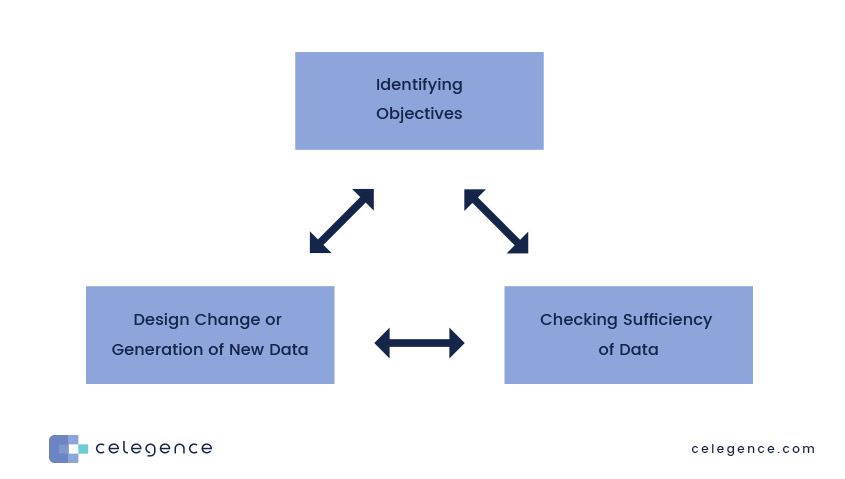
Conclusions
- Identifying claims creates the objectives of your clinical evaluation, it shows that the device achieves its intended purpose safely – Your first focus while doing a clinical evaluation is to identify the objectives. What are you hoping to demonstrate? Why is this a clinical evaluation? These objectives come from determining the claims that you’re hoping to establish for your device. It is not always necessary that your claims have to be something that is apart from your intended use. You can always say that you claim that your device functions as intended and achieves so and so clinical benefit, and then establish how you’re going to demonstrate that it achieves this clinical benefit, which is a perfectly reasonable claim and an objective to make.
- It helps you determine what data is lacking for your device – The next step is to check how much data you have for demonstrating these objectives. Do you have sufficient data? Do you have the right kind of data? Is it clinical? Is it non-clinical? Is it going to be accepted? If you have only non-clinical data, is there a reason? Is it something that you will be able to justify?
- Determining the medical benefits and identifying the expected clinical outcomes makes it easier to demonstrate the acceptability of the benefit-risk profile of the device.
- This exercise helps to identify any holes in the information provided with the device and the risk management process currently in place.
If you do not have enough data to demonstrate a particular claim, or if you do not have enough data to demonstrate any of the objectives that you have identified. Then you have to reevaluate if you are claiming the right things, does your device need or design change? or does it need reevaluation to make sure that it in fact demonstrates these claims? Or is it just that you must rephrase the claims in such a way that you can demonstrate it via the data that you have. So doing this entire process of identifying your claims and checking the amount of data that you have should be done at the very beginning of a clinical evaluation, because it does result in change of the IFU in certain cases making sure that the verbiage is not something that can mislead the user or the patient.
So doing this at the very beginning of your clinical evaluation, before you start drafting the CER, before you even start putting in all of the data is a very good practice and that is how we work at Celegence to make sure that we have all the data in place before starting off the clinical evaluation, just so that we don’t go back and change the IFU or the operator manual, which results in a change of the entire evaluation process, where you have to go back and rerun the searches and redo everything. So, to avoid that rework, it is best to do this at the very beginning of your clinical evaluation.
Experts in Device Claims
Celegence provides the medical device industry with consulting services that are tailored to the evolving needs of manufacturers. Our suite of services including EU MDR related support allows you to focus on your core responsibilities. With our guidance, bringing your devices to the market and keeping them there will be easier for your regulatory and quality teams.

